
By Lee Weinstein: From the early days of Hollywood until the early 1950s the serialized chapter play enjoyed a heyday of popularity. Yet, of the countless films of this genre, very few are remembered today; it is a dead artform. The low-budgeted, low-quality Saturday afternoon cliffhangers no longer hold the general appeal they once did.
One of the notable exceptions to this decline in popularity, however, is the trilogy of Flash Gordon epics produced by Universal in the late 1930’s. In their own time, they were unique in being billed at theaters ahead of the features they accompanied. Even today, they remain popular among adult audiences. In the 1970’s, Flesh Gordon (1974), an X-rated parody of the films was released to immediate success and has become a cult classic of its own.
One reason for the lasting popularity of the Flash Gordon serials is the relatively high budget afforded them. The first, Flash Gordon (1936), cost about $350,000, making it the most expensive serial ever made, and its two sequels, while made for considerably less, still had relatively high budgets.
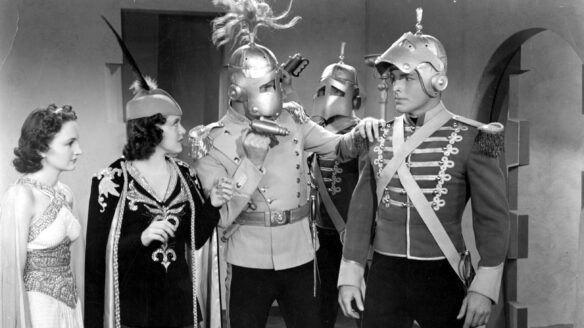
However, another reason for their unprecedented popularity might well be their appeal to mythic chords in our subconscious. Beneath the superficialities of good versus evil running through the plot lines, runs a more symbolic structure.
Sun imagery has been a common motif throughout the history of literature, including the works of Shakespeare. This motif, employed both visually and symbolically, also occurs in the three serials, but can be seen most strongly on the third and last of the series, Flash Gordon Conquers the Universe (1940).
From beginning to end of the twelve chapter serial, the image of the sun appears again and again in the sets and costumes, as well as the dialog. The chest emblem of Flash’s uniform, the emblem worn by the prince of the Rock Men, the alarm bell in Ming’s palace, and the sunburst designs decorating some of the palace doorways are all examples.
The reasons for this imagery begin to emerge when the substructure of the story is analyzed. The plot involves four kingdoms on the planet Mongo: Ming’s kingdom (also called Mongo); Prince Barin’s kingdom of Arboria; the icy kingdom of Frigia; and the “Land of the Dead” inhabited by the Rock Men.
It can be seen that these correspond to the four classical elements: Fire, Air, Water and Earth, respectively. Can it be a coincidence that the soundtrack of the serial consists, to a significant extent, of “Les Preludes” by Liszt? It was originally written as a prelude to “Les Quatre Elements,” a choral orchestral setting for a sequence of poems by Joseph Autran.
Ming the Merciless has become the symbolic fire-element by harnessing the sun’s power and using it to power his purple death dust, in his ambition to conquer the universe. This was actually foreshadowed in the second serial, Flash Gordon’s Trip to Mars (1938), when in an early chapter, Ming demonstrates his ability to walk through fire with impunity.

A steady progression in Ming’s ambition can be seen running through the three serials. In Flash Gordon (1936) he is in the process of conquering his own planet, Mongo. In the second, Flash Gordon’s Trip to Mars, he has begun to take over other planets. And in the last serial, he is intent on conquering the universe.
It is in this final stage, then, that the fire element he represents becomes identified with the sun. His throne is ornamented by a sunburst-like backdrop, and sunbeams can be seen pouring through the throne room windows. Even his warning system of alarm bells are sun-shaped, remotely representing his authority.
It is no surprise, then, that in the first third of the serial, Flash discovers that they can only neutralize the purple death dust with “polarite,” a substance found only in the cold wastes of Frigia. Polarite is obviously a manifestation of the classic element water, to which is attributed the properties of coldness and wetness.

The attributes of the element air, hotness and wetness, are to be found only in the lush forests of Arboria. As air is the only element as subtle and invisible as fire, so must Arboria be the stronghold of the enemies of the evil Ming. The forest kingdom must regain control of the sun, usurped by Ming for his nefarious ambitions, for theirs is a kingdom of life, and life depends on the sun.
Symbolically, this can be seen in the neutralizing ray developed by Flash’s scientist mentor, Dr. Zarkov, in Arboria, to render Ming powerless. This weapon does not run on solar power and cannot be used within Arboria because it creates around itself a by-product of poisonous gas.
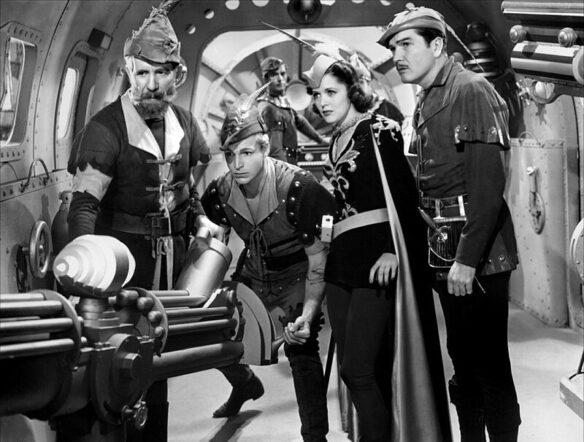
It is interesting that up to this point Flash has been garbed in the traditional Arborian uniform. Until now, he has been acting defensively, in saving the earth from the death dust. But now, he has taken the offensive, directing his attack against Ming, himself, and it is only now that he dons his sun-emblem bearing costume; the sun-emblem black, denoting opposition to Ming.
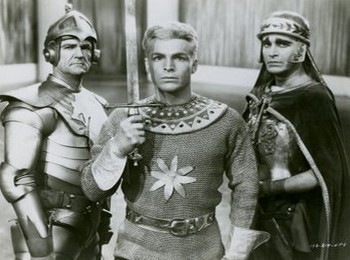
The neutralizing ray, due to its poisonous nature, is taken to the Land of the Dead to be used, but its impotence becomes fully realized with the discovery that the land is inhabited. A race of Rock Men lives there, representing earth elementals. Both Flash’s party and Ming’s (represented by Captain Torch) [emphasis mine] are captured by them and held responsible for the disappearance of the Rock King’s son.
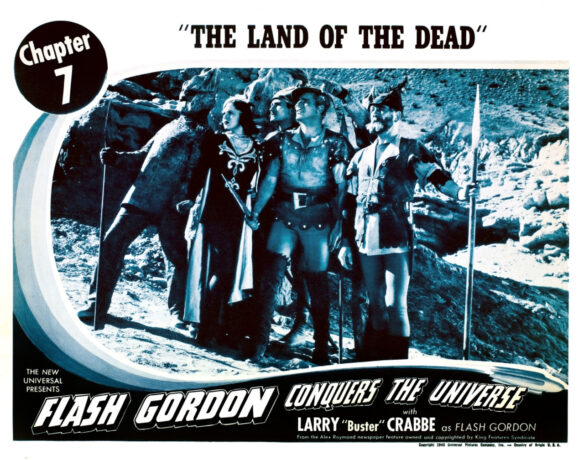
In reality, the boy has been trapped by a giant lodestone, uncovered by Capt. Torch earlier. It is Flash’s rescue of the boy that frees them from the symbolic earth-force and allies them with their former captors. It is especially significant that the boy wears on his chest a black sun emblem similar to Flash’s. It is the appearance of this sun-bearing boy that results in the alliance.
Now Flash has the backing of all three elements, earth, air, and water, against the tyrannical sun/fire figure. As the serial draws to its conclusion, Dr. Zarkov, barricades himself into Ming’s laboratory and discovers for himself that it has indeed been solar power that Ming has been using to power his weapons. Having been found out by his enemies, Ming threatens them with another weapon, a rocket ship loaded with explosive “solarite.” If he cannot use the sun in one way, he must use it in another.
Note here the similarity between the words “solarite” and “polarite.” The fire – water analogy is almost too obvious. It is this solarite-bearing ship that is to bring about Ming’s destruction, as control passes out of his hands and into the hands of Flash and his allies.
Yet beneath this elemental symbolic structure lies something considerably deeper. The sun is more than a mere representation of fire. As in Elizabethan drama, it relates to a philosophical and political ideology wherein the ruler of a kingdom is seen as the center of state, as the sun is the center of the solar system.
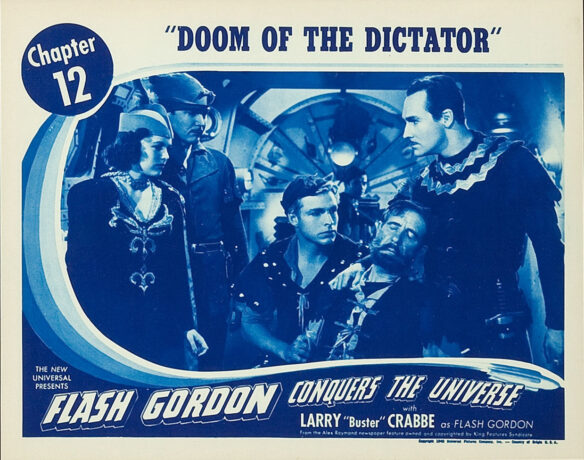
When Ming is told by Flash and his allies that they mean to save the universe from him, and he replies, “I am the universe,” it is merely an extrapolation of this idea. All the events of the story, and presumably the fate of the universe, are revolving around the pivotal character of Ming. When Flash conquers Ming, he has, in effect, conquered the universe, from whence derives the title.
Pervading this universe is the fifth element, ether, giving it coherent unity. This is represented by the simple sparking effect of most of the weapons used on both sides of the battle. The magnetic forces in The Land of the Dead, the rays from Flash’s gun, and the rays from Ming’s Annihilaton robots are all extensions of one and the same all pervading etheric force. Thus Ming, being part of the physical universe in this material sense, as well as the central sun figure around which it revolves, cannot rise above it.
Like the classical tragic hero, he necessarily brings about his own destruction by means of the symbolic solarite. But the real hero, Flash Gordon, rocketing back to earth at the close, leaves in his burning wake a new myth; a myth that has been with us since 1940 and may well last for centuries to come.
[This article first appeared in the fanzine The Hunting of the Snark #4, 1976 in a slightly different form]
[Lee Weinstein’s website is: https://leestein2003.wordpress.com/]
Discover more from File 770
Subscribe to get the latest posts sent to your email.

HA! A blast from the past. I did the title lettering for this article. Now I have to find my copy…
So Water is coldness and wetness, while Air is hotness and, um, wetness? Not entirely sold on the concept here. But say what you will about Ming, he had excellent taste in companions.
Silliest caption award winner: “Charles Middleton, right, as Ming the Merciless,” showing woman, left, man, right!
Sending you GIFs you can hopefully insert.
Actually, I am right now finishing up the script for a serial based on Flash Gordon, for a very tiny niche market. But those of us who love serials really love them.
You know: like George Lukas and “Fighting Devil Dogs,” another of my favorites.
The rocket ship used in the serials was first used in the film JUST IMAGINE,
The film is something of a dud.